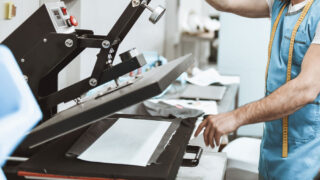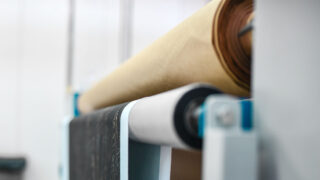Types of Printing
Flatbed Screen Printing
Flatbed screen printing can be considered an automated version of the older hand-operated silkscreen printing process used on t-shirts, sweatshirts, and other printed items. For each color in the print design, a separate screen must be constructed or engraved. If the design has four colors, then four separate screens must be engraved.
The modern flatbed screen printing machine consists of an infeed device, a glue trough, a rotating continuous flat rubber blanket, flat bed print table harness to lift and lower the flat screens, and a squeegee.
The infeed device allows for precise straight feeding of the fabric onto the rubber blanket, as the cloth is fed to the machine it is lightly glued to the blanket to prevent any shifting of the fabric or distortion during the printing process. The blanket carries the fabric under the screens which are in the raised position.
Once under the screens, the fabric stops. The screens are lowered and then the automatic squeegee moves across each screen pushing print paste through the design or open areas through the screens. The screens are raised, the blanket precisely moves the fabric to the next color and the process is repeated. Once each color has been applied the fabric is removed from the blanket. The fabric moves through the required fixation process. The rubber blanket is continuously washed, dried, and rotated back to the fabric infeed area.
The flatbed screen process is a semi-continuous, start-stop operation. From a productivity standpoint, the process is slow with production speeds in the range of 15-25 yards per minute. Flatbed screen printing also has design limits. The design repeat size is limited to the width and length dimensions of the flat screen, no continuous patterns such as linear stripes are possible with this method.
However, flatbed printing offers a number of advantages. Very wide machines can be constructed to accommodate fabrics such as sheets, blankets flags, carpets, or upholstery. Flatbed printing also allows multiple passes or strokes of the squeegee so that large amounts of print paste can be applied to penetrate pile fabrics such as blankets or towels.
Rotary Screen Printing
Due to the production and pattern limitations of flat bed screen printing, inventive machinery manufacturers developed rotary screen printing in 1963. Imagine taking a flat screen and shaping it into a roll by sealing the ends together and you have a rotary screen. This simple modification converts the semi-continuous process of flatbed printing to a continuous one.
The basic operations of rotary screen and flat screen printing machines are very similar. Both use the same type of infeed device, glue trough, rotating blanket or print table, dryer, and fixation equipment.
The first step in rotary screen printing is feeding the fabric onto a rubber blanket. The fabric then travels under the rotary screens one screen for every color in the design. The screens rotate as the fabric passes underneath. Print paste is continuously fed to the interior of the screen through a color bar or pipe. As the screen rotates, the squeegee device pushes print paste through the design areas of the screen onto the fabric.
By converting the screen printing process from semi-continuous to continuous, higher production speeds are obtained. Typical speeds are from 30–60 yards per minute or 27–54 meters per minute. Some patterns, depending upon design complexity and fabric construction, can be printed at even higher speeds.
Rotary screen machines are more compact than flat screen machines, therefore they use less plant floor space. The size of the design repeat is dependent upon the circumference of the rotary screen. This was initially seen as a disadvantage because the first rotary screens were small in diameter. Today’s screens are available in a wide range of sizes.
Modern rotary screen machines are highly productive. They have few design limitations and can be used for both continuous and discontinuous patterns. It is estimated that approximately 65% of the worldwide printed fabric market utilizes the rotary screen technique.
The principal disadvantage of rotary screen printing is the high cost of the equipment. Rotary screen printing is generally not profitable for printing small orders because of the time required to change screens and perform the necessary cleaning operations.
There are several common print defects associated with screen printing. These include machine stops, out of registration where the pattern is out of fit, glue streaks from the rubber blanket, color smear, color out from the lack of print paste, creased fabric, seam marks, lint on the fabric causing pick off, and lint of the screen causing stick in.
Machine stops count for as much as 40% of all defects. Remember with print designs, print application must be correct the first time because printing defects cannot be repaired. There have been many new and exciting improvements in screen printing in recent years, especially in the case of rotary screen machines. The use of microprocessor control systems has allowed for printing that is more accurate with reduced print defects and increased productivity. New techniques for recovery and reuse of unused print paste have reduced dye and chemical costs as well as the pollution load on wastewater treatment systems. Overall, these improvements have produced machines capable of better quality printing at higher productivity levels with fewer defects and reduced environmental impact. This having been said, it is still the fabric and the handling of the fabric in the printing process that accounts for many of the listed defects.
Creating the Screen Engraving
The process of putting designs to be printed on both rotary and flat screens is known as screen engraving. The most widely used technique for screen engraving is known as the lacquer method.
This process begins with the creation of a print design. Once the design is finalized, a textile artist separates the design into its individual colors. A nickel-plated screen with approximately 12,000 holes per square inch is mounted in the coding station. The screen is then coated with a liquid color soluble photo-sensitive resin. The coated screen is carefully moved to a drying oven. It is then stored in a controlled environment for up to 48 hours prior to engraving.
At the engraving stage, the film with the opaque design is secured to the screen. A high-intensity light is then directed onto the screen, where ever the light hits the screen, it hardens the resin and forms a water-soluble barrier. Where light is prevented from hitting the screen due to the presence of the unique design, the resin remains water soluble.
After the proper amount of light exposure time, determined by the choice of resin, the screen is washed and dried. The design areas of the screen are opened and print paste is allowed to flow freely through, but the non-design areas are closed. The screen is cured in an oven to make the lacquer permanent. The lacquer engraving technique is used for nearly all flat screens.
For rotary screens, the most modern method of screen making is known as laser engraving. A skilled textile designer separates each color of the design into a digital file using a CAD or Computer Aided Design system. Concurrently, rotary screens are coated with resin using the same process employed with the lacquer technique. However, in this case, the resin is cured prior to laser engraving so it has a longer shelf life. The coated screen is loaded on a mandrel which is part of the laser engraving machine. The laser engraves the screen using the digitized CAD print design data. As with the lacquer technique, only one color per screen is possible. The laser vaporizes the resin without damaging the screen material which is nickel mesh.
Once the screen has been engraved, the motif on the screen is carefully inspected to ensure an accurate match to the color separation file derived from the original design. Laser engraving has greatly expanded the design possibilities for rotary screen printing.
There is also a technique known as the Galvano method for creating screens using nickel electroplating technology. The Galvano method allows for gradients of color as the screen can be constructed with different-sized cells. Intricately designed screens are possible with this technique.
To create a Galvano screen, a photo-sensitive chemical is first sprayed onto the base. Next, a negative of the image is placed on the base and an intense UV light cures the photo-sensitive chemical in areas not protected by the negative image. The unexposed chemical is washed away. The base is then placed in a nickel plating solution. The nickel is attracted to and plates the areas of the base that do not contain the photo-sensitive solution. This process forms the Galvano screen. The screen is then carefully removed from the mandrel.
Engraved Roller Printing
Engraved roller printing is a continuous printing process developed in the late 18th and early 19th centuries. Until the development of rotary screen printing, it was the only continuous fabric printing technique available. In this method, a heavy copper cylinder is engraved with the print design. Copper is soft, so once the design is engraved the roller is electroplated with chrome for durability.
The print design process and color separation are identical to that used for screen printing. Once each roller is engraved, it’s loaded on the printing machine. There is one roller per color in the design. Each roller is fed print paste by a furnish roller rotating in a color box full of print paste.
As print paste is applied to the print roller a stationary doctor blade scrapes away excess surface print paste leaving only that which is embedded in the design etchings. The print cloth is fed into the machine backed by a greige fabric to absorb print paste flow through. A cushioning print blanket backs the greige fabric. The greige fabric and the print blanket are washed, dried, and reused. Printing occurs as the fabric swipes print paste from the print roller as it passes through the pinch point between the roller and the main cylinder.
The high fixed cost of copper rollers, the expense of the engraving process, and the possible distortion of fabric during printing have led to its reduced use, now being less than 5% of the worldwide textile printing market. The primary advantage of this technique is the fine design detail.
Digital Inkjet Printing
Of the various methods of textile printing, digital printing provides a world of possibilities for the design of cotton fabrics. Currently, screen printing is the most common type of printing technique, but it has some limitations when compared to digital printing. Rotary screen printing accounts for approximately 65% of printed goods, while flat-bed screen printing accounts for about 17% of the market. Both methods require fairly high development time and costs because a screen must be prepared for each color in the print design.
Digital printing is used to rapidly produce trial prints for sale or evaluation. Many industry leaders believe digital printing has the potential to become the textile printing technique of the future. The current top digital printing speeds are substantially lower than those of a rotary screen machine. However, this comparison does not take into account the production downtime required for screen change and clean-up necessary in rotary screen printing. The limiting factor of digital printing speed is related to print head technology. Reports indicate that these production speeds will not increase until there is a breakthrough in the mechanics of the printing heads. Current research in this area is focusing on increasing the current color depth and color fastness of the dye systems now available. Generally, the fabric to be printed must be pretreated with a material such as sodium alginate and alkali so the printed dye will not bleed or smear before fixation.
Regardless of the technical limitations, digital inkjet printing is a viable commercial alternative technique for small runs, 50 yards and under, of highly styled, premium fabrics as are used in scarves and ties.


